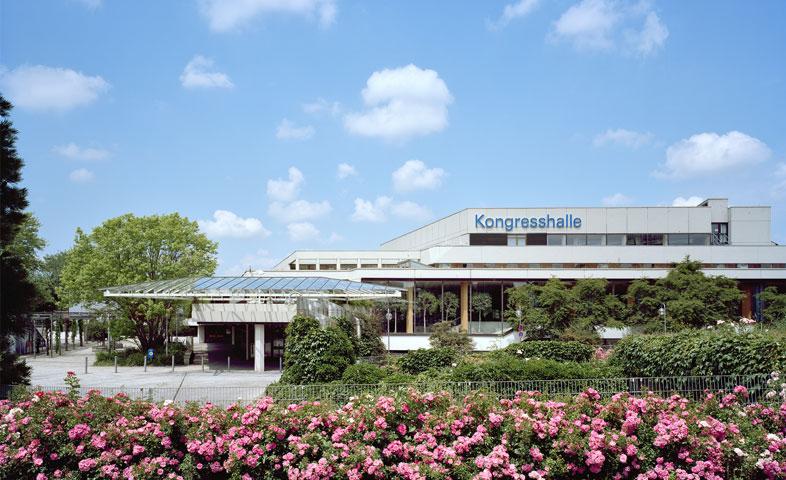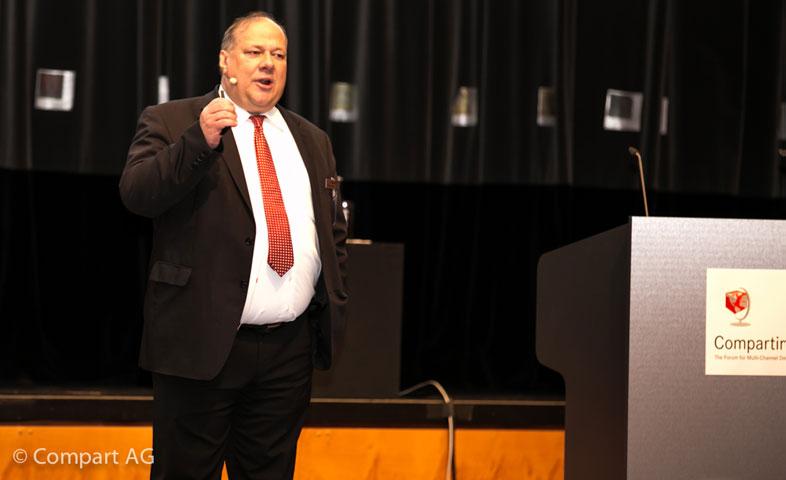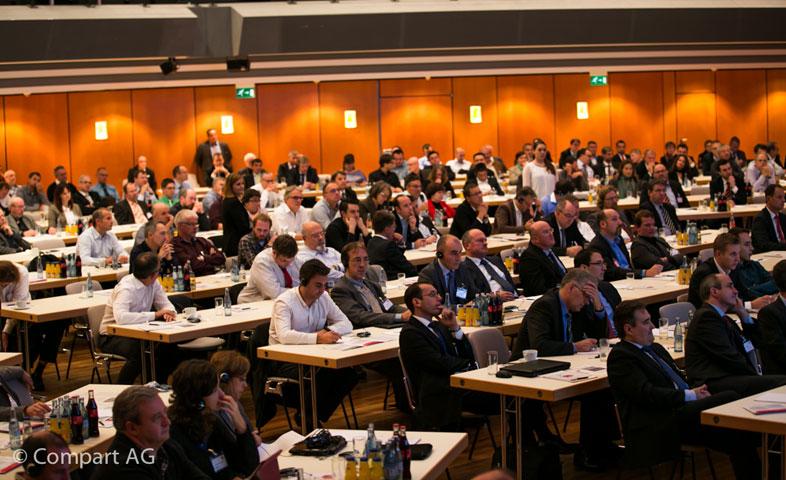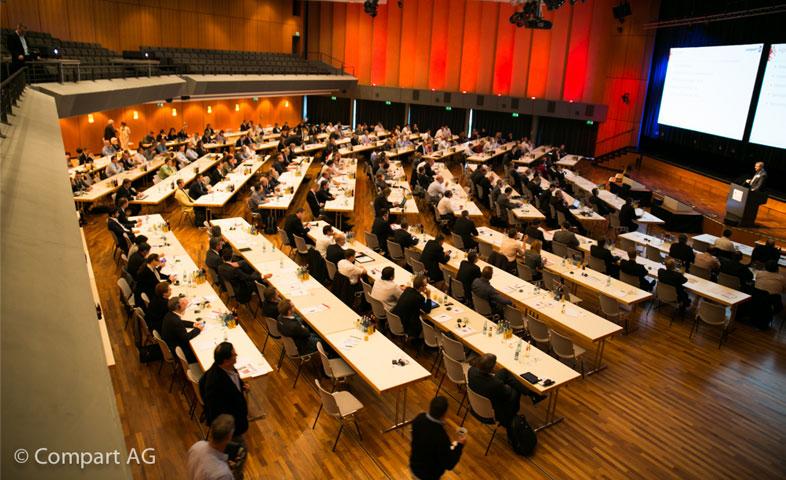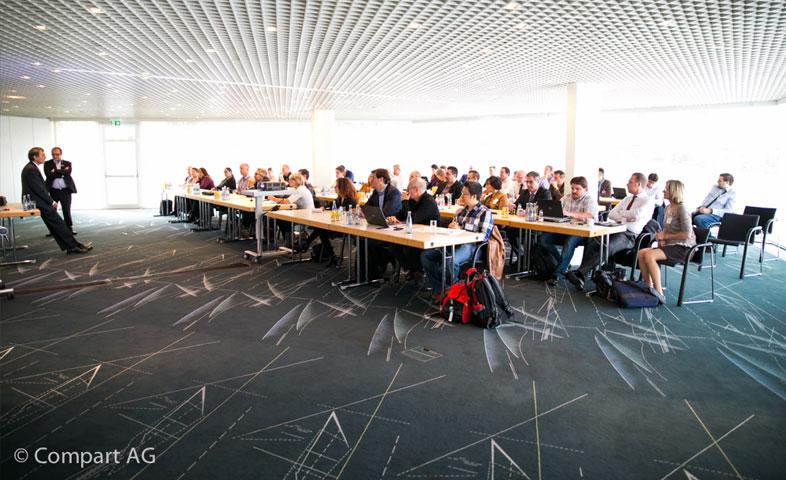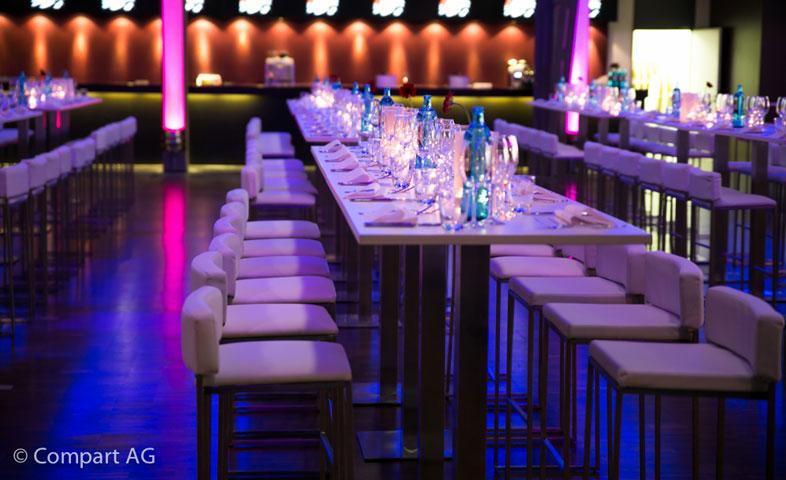
Ditch the pages, focus on content:
Comparting hails a new age in document processing
Conference for multi-channel document and output management even more international than ever: 37 nationalities from 14 countries represented.
Böblingen, October 2015 – This year’s Comparting at the Böblingen Kongresshalle wrapped up with the following conclusion: Customer communication will increasingly revolve around document processing. The two-day international forum, now in its eleventh year, again set a clear course. Its primary focus was how companies can arm themselves for increasingly digital customer communication. In his forward-looking presentation, Harald Grumser, founder and CEO of Compart, stressed the importance of cutting loose from the 8 ½ x 11 standard. An 8 ½ x 11 document is not really suited to the new world of communication: It is difficult to display, much less process, on smartphones and other mobile devices.
In document and output management, Grumser noted, it is more important to transfer the content, keeping it independent of the transmission method. That requires separating document creation from delivery, outside the given application. Grumser surprised his audience by pointing out that even current trends such as HTML5 are just a stepping stone on the path to optimized multi-channel document management and output.
Recipient determines the communication channel
The relationship between content and form in customer communication continued to thread its way throughout the forum, which, with participants from 37 countries, was more international in character than ever. German author, journalist and crowd-funding pioneer (“A new version is available”) Dirk von Gehlen, from the “Süddeutsche Zeitung,” made it clear right at the outset that communication in the 21st century is shaped more than ever by the circumstances in which it takes place. In other words, the value of information rests not exclusively on the content, but on how and it what form it is communicated. For document and output management, that means that not all content is appropriate for every communication channel, and vice versa. It is rather the recipient that determines the delivery method, whether in digital (e-mail, web, social media) or traditional analog form (letter, fax, etc.). Yet a customer’s communication behavior may change in a flash, requiring companies to remain open to all channels and be able to integrate them into their existing output management structures.
Physical and digital communication are converging
Multi-channel capability also surfaced repeatedly in the other expert presentations. Allianz Deutschland discussed one of their largest IT projects in the last several years. The financial services provider has set up a completely new output management system (OMS) and continues to work on its development. At its core is a central data platform that controls delivery for all channels, including media such as E-Post, De-Mail and Short Message Service (SMS). Ulrich Schäck explained that Allianz, as a market leader in the insurance industry, needed to meet the demands of the new digitalized world and take a pioneering role in document processing.
The presentation from Swiss Post Solutions (SPS), the world’s largest document management services provider, likewise made clear that connecting the physical and the digital in the world of communication is unavoidable. The fully owned subsidiary of the Swiss Post has proven expertise in workflow optimization in document management. This includes complete handling of mail processing for customers, such as distributing incoming business correspondence, which is automatically forwarded to employees in digital form and electronically archived. Alexander Schäfer, senior manager in Global Solution Design at SPS, discussed the opportunities for growth presented by new business fields such as cognitive computing (artificial intelligence) and robotics process automation (RPA) in document processing. Swiss Post Solutions, one of the leading output service providers in Europe with an annual output of 1.2 billion pages, has been cooperating successfully with Compart for many years. One of the key projects was the development of the ePostSelect hybrid mail platform, a solution for the physical and digital delivery of documents (E-post, De-Mail, IncaMail, etc.) that is also being used by the Deutsche Bahn.
Content and form go their separate ways
Separating content from form in document processing dominated the agenda. This issue also impacts the localization of content, as Jeremias Märki stressed in his presentation. While some may relegate the topic to the sidelines, multilingualism is a must in many countries. According to Märki, there are many good reasons to localize documents, but there are a few things to consider that go beyond just straight translation. In this context, separating content from its display is important.
The various aspects of multi-channel document and output management dominated the agenda even more so than in previous years. IBM presented its BluePostBox, a solution for mobile document creation. The principle: The recipient can electronically retrieve any type of document from a virtual mailbox, including via smartphone. This digital document store is extremely secure thanks to its high encryption standard and is also convenient for the sender, who can seamlessly integrate IBM BluePostbox in mobile apps (iOS/Android) and customer portals for sending documents over mobile end devices and the web. The IBM solution is comparable to long-standing, successful electronic mail portals like eBoks (Denmark) and Metaposta (Spain), which was a topic at Comparting 2012.
ThyssenKrupp Steel Europe AG reported on a major overhaul in output management within the company. The core task was to implement and establish an automatic dispatch service that familiarized employees with cost-optimized mailing (delivery slips, credit notices) and to set up an enterprise-wide, globally oriented scanning service for the entire ThyssenKrupp group.
As expected, the “Out of the Compart Lab” segment generated its usual buzz with innovations from applications and basic development. The key highlights: new filters for label and matrix printing (ESC/P, Zebra, Datamax) as well as high-volume transaction printing (IPDS/VIPP), features for quality assurance as an integral component of all solutions from Compart as well as for generating customized reports and a web-based document display. It was clear that web services underlie application development at Compart and that more effort is being directed toward transactional processes.
It’s all about content
Media presence was likewise international. Journalists from Germany, Austria, France and Spain joined the press conference with Compart CEO and regional managers to learn about the latest challenges in modern communication. To kick off the round table, Harald Grumser highlighted the key trends: increasing co-existence of batch and transaction processing, and the development of customized, flexible multi-channel document platforms that can work with any type of communication channel when required. Again, the Comparting motto applies: Separate content from layout. In the final analysis, the data is paramount, and it must be available in every context in which modern communication occurs. Formatting and layout need to be done immediately before output, that is, much later than typically done today.
The CEO also underscored the fact that high-volume production printing remains an important topic in the digitalization of output management. In this context, greater efficiency coupled with 100% quality assurance are key.
The technical program included a presentation by the Polish print service provider Inforsys that addressed this very topic. This rapidly expanding company recently teamed up with technology partner Xerox to upgrade its hard- and software architecture, with high-performance, full-color Impika printers and DocBridge Queue Processor at its core. The solution developed by Compart is a platform-independent system for central management of different process workflows in output management. The software bundles all incoming jobs regardless of their originating channels or applications and prepares them for further processing while optimally utilizing resources. Inforsys also deploys the DocBridge Queue Processor as an IPDS spooler. Modernization was critical for the company to keep pace with market developments in full-color printing such as cost pressure, inkjet technology and transpromo as well as specific customer requirements such as white paper production. According to Inforsys CEO Witold Szczurek, the previous infrastructure had reached its limits.
Inkjet production printing was also discussed elsewhere in the Comparting program. Arjen Goldschmidt of Canon Europe shared his wealth of project experience in the introduction of color, which along with its many opportunities brings with it a number of challenges, especially in data preparation. It basically affects a company’s entire business model, according the specialist for digital, offset and screen printing and color management. It is important to fully understand not only the strengths of inkjet technology, but also its limits. Goldschmidt underscored that only then could its potential be fully realized. Inkjet surpasses other digital print technologies in productivity and is still less costly.
Comparting is multicultural
As always, it was the mixture of strategy presentations and real-world user reports that drew in the visitors from Germany and abroad. It is the diversity of different solution approaches that has distinguished Compart over the years and makes it attractive to companies of different industries, regions and structures. The separate track devoted to the French market was again part of the Comparting agenda. The significance of Germany’s neighbor as a market with enormous potential for growth was also reflected in the increase in the percentage of French attendees in the audience over last year: reason enough to include a presentation in French in this year’s main program. Thanks to simultaneous interpreting in German, English and French – a first in Comparting’s eleven-year history – participants were able to get more out of the presentations. One thing was especially clear: Even though German still dominates as the conference language, Comparting has grown more international.
The “Babylonian babble” in the Böblinger Kongresshalle and at the soireé was eloquent evidence of that fact. This year’s participants had even more opportunities than in previous years to make contacts and exchange ideas with other attendees.
The end of mediocrity
Traditionally the last item on the agenda – and a Comparting fixture – is a presentation that at first glance has little to do with document and output management, but on closer inspection proves otherwise. This year, Michael Carl from the “2bAhead Think Tank” discussed future forms of customer dialog, which will be increasingly individualized. Instead of standardized communication, which still predominates in many companies, the analyst predicted that communication would be divided into premium and economy segments. This brought the forum full circle: Dirk von Gehlen’s opening keynote had addressed the “end of mediocrity” in communication and called for a different approach to digital media and technology.
The next Comparting will be held October November 17–18, 2016. For more information and how to register, see the “Event” section on this website in early 2016.
"I am going home with a positive feeling; My compliments to everybody!"
Comparting attendee
Program
Theoretical and practical knowledge around document processing and output management.
Speakers

Harald Grumser
Compart
Digital Communication - Away from the Pages Towards the Content

Dirk von Gehlen
Süddeutsche Zeitung
The end of mediocrity - how digitalization changes our society (Keynote)

Oliver Helfrich
ThyssenKrupp Steel Europe AG
Multi-channel Document Management by Inclusion in Multi-Dimensional Structural Transformation

Thomas Simon
docsellent GmbH
Smart Solutions for Dynamic Output - Realized with DocBridge Mill

Michael Carl
2b AHEAD ThinkTank
Kunden 2025: Dialog mit vielen Unbekannten?
"Presentations from Experts, for Experts!"
Comparting attendee
"Plenty of time for intense discussion, and very enjoyable."
Comparting attendee


